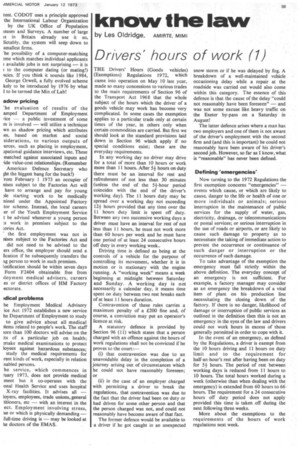know the law
Page 61

If you've noticed an error in this article please click here to report it so we can fix it.
by Les Oldridge, AMIRTE, MIMI
D rivers' hours of work (1)
THE Drivers' Hours (Goods vehicles) (Exemptions) Regulations 1972, which came into operation on May 10 last year, made so many concessions to various trades to the main requirements of Section 96 of the Transport Act 1968 that the whole subject of the hours which the driver of a goods vehicle may work has become very complicated. In some cases the exemption applies to a particular trade only at certain times of the year, in others only when certain commodities are carried. But first we should look at the standard provisions laid down in Section 96 which apply if no special conditions exist; these are the everyday requirements.
In any working day no driver may drive for a total of more than 10 hours or work more than 11 hours. After 5+ hours on duty there must be an interval for rest and refreshment of not less than 30 minutes (unless the end of the 51--hour period coincides with the end of the driver's working day). The 11 hours duty may be spread over a working day not exceeding 121 hours provided that any time over the 11 hours duty limit is spent off duty. Between any two successive working days a driver must have an interval for rest of not less than 11 hours, he must not work more than 60 hours per week and he must have one period of at least 24 consecutive hours off duty in every working week..
Driving time is defined as being at the controls of a vehicle for the purpose of controlling its movement, whether it is in motion or is stationary with the engine running. A "working week" means a week beginning at midnight between Saturday and Sunday. A working day is not necessarily a calendar day, it means time spent on duty between two rest breaks each of at least 11 hours duration.
Contravention of these rules carries a maximum penalty of a £200 fine and, of course, a conviction may put an operator's licence at risk.
A statutory defence is provided by Section 96 (11) which states that a person charged with an offence against the hours of work regulations shall not be convicted if he proves to the court:— (i) that contravention was due to an unavoidable delay in the completion of a journey arising out of circumstances which he could not have reasonably foreseen;
Or
(ii) in the case of an employer charged with permitting a driver to break the regulations, that contravention was due to the fact that the driver had been on duty or had driven for some other person and that the person charged was not, and could not reasonably have become aware of that fact.
The former defence would be available to a driver if he got caught in an unexpected snow storm or if he was delayed by fog. A breakdown of a well-maintained vehicle occasioning delay while a repair at the roadside was carried out would also come within this category. The essence of this defence is that the cause of the delay "could not reasonably have been foreseen" — and was not some excuse like heavy traffic on the Exeter by-pass on a Saturday in August!
The latter defence arises where a man has two employers and one of them is not aware of the driver's employment with the second firm and (and this is important) he could not reasonably have been aware of his driver's second job. However, so far as I know, what is "reasonable" has never been defined.
Defining 'emergencies' Now turning to the 1972 Regulations the first exemption concerns "emergencies" — events which cause, or which are likely to cause, danger to the life or health of one or more individuals or animals; serious interruption in the maintenance of public services for the supply of water, gas, electricity, drainage, or telecommunications or postal services; or serious interruption in the use of roads or airports, or are likely to cause such damage to property as to necessitate the taking of immediate action to prevent the occurrence or continuance of such danger or interruption or the occurrence of such damage.
To take advantage of the exemption the emergency must fall strictly within the above definition. The everyday concept of an emergency is not sufficient. For example, a factory manager may consider as an emergency the breakdown of a vital item of plant on his production line necessitating the closing down of the factory. If there is no danger, likelihood of damage or interruption of public services as outlined in the definition then this is not an emergency in the eyes of the law and drivers could not work hours in excess of those generally permitted in order to cope with it.
In the event of an emergency, as defined by the Regulations, a driver is exempt from the 10 hours driving and 11 hours on duty limit and to the requirement for half-an-hour's rest after having been on duty for 51 hours. The period of rest between working days is reduced from 11 hours to 10 hours. The total hours worked during a week (otherwise than when dealing with the emergency) is extended from 60 hours to 66 hours. The requirement for a 24 consecutive hours off duty period does not apply provided this time is taken off during the next following three weeks.
More about the exemptions to the requirements of the hours of work regulations next week.








































































































